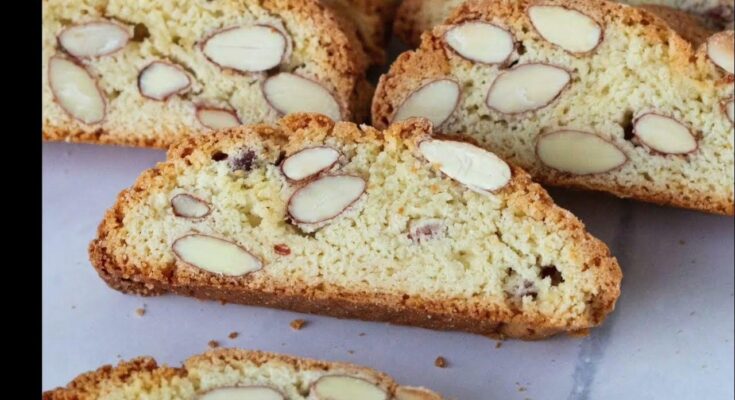Biscotti Recipe: Biscotti, the classic Italian cookie, is loved for its crunchy texture and versatility. Traditionally enjoyed with coffee or tea, biscotti has been a favorite for centuries.
The name “biscotti” comes from the Latin word biscoctus, meaning “twice-baked,” which is the secret to its unique texture. Whether you’re a seasoned baker or a beginner, making biscotti at home is not only rewarding but also allows you to customize flavors to your liking.
Let’s dive into this step-by-step guide to create perfect biscotti from scratch.
Ingredients Needed for Biscotti
Creating biscotti requires simple, pantry-staple ingredients. Here’s what you’ll need:
Basic Ingredients:
- 2 ¾ cups of all-purpose flour
- 1 cup of sugar
- 1 teaspoon of baking powder
- ½ teaspoon of salt
- 3 large eggs
- 1 teaspoon of vanilla extract
- 1 teaspoon of almond extract (optional)
Optional Add-ins:
- 1 cup of chopped almonds or hazelnuts
- ½ cup of dried cranberries, raisins, or chocolate chips
- Zest of one orange or lemon for a citrusy touch
These ingredients are highly adaptable, so feel free to experiment with your favorite flavors.
Essential Tools for Making Biscotti
To ensure your biscotti turns out perfectly, you’ll need:
- A large mixing bowl
- Measuring cups and spoons
- A sturdy whisk or electric mixer
- A silicone spatula
- A baking sheet lined with parchment paper
- A sharp serrated knife for slicing
- A cooling rack
Using high-quality tools can simplify the process and enhance the final result.
How to Make Simple Biscotti
Step 1: Preparing Your Workspace
Before you begin, set yourself up for success:
- Clean and Organize: Ensure your workspace is tidy and free from distractions.
- Preheat the Oven: Set your oven to 350°F (175°C). Proper preheating is essential for consistent baking.
- Prepare the Baking Sheet: Line it with parchment paper or a silicone baking mat to prevent sticking and promote even baking.
Taking a few moments to prepare will make the baking process smoother and more enjoyable.
Step 2: Mixing the Dough
- Combine Dry Ingredients: In a large bowl, whisk together the flour, sugar, baking powder, and salt.
- Add Wet Ingredients: Beat the eggs in a separate bowl, then mix them into the dry ingredients along with the vanilla and almond extracts.
- Incorporate Add-ins: Gently fold in your choice of nuts, dried fruits, or chocolate chips.
- Check Consistency: The dough should be sticky but manageable. If it’s too dry, add a teaspoon of water or milk.
Mixing the dough correctly ensures your biscotti will have the ideal balance of flavor and structure.
Step 3: Shaping the Dough
- Divide and Shape: Split the dough into two portions. Roll each into a log approximately 10-12 inches long and 2 inches wide.
- Adjust Size: For smaller biscotti, make thinner logs. Larger logs yield thicker biscotti.
- Flatten Slightly: Press the tops lightly to create a smooth surface.
Proper shaping is crucial as it determines the size and shape of your biscotti slices.
Step 4: First Bake (The Initial Bake)
- Place the logs on the prepared baking sheet, leaving enough space between them to expand slightly.
- Bake for 25–30 minutes or until the logs are firm and golden brown.
- Remove from the oven and let them cool on the baking sheet for 10–15 minutes.
This step sets the foundation for the biscotti’s signature texture.
Step 5: Cooling the Logs
- Transfer the logs to a cooling rack. Allow them to cool completely before slicing to prevent crumbling.
- Pro tip: Use a serrated knife to cut neat slices.
Cooling properly is key to achieving clean, uniform slices without breaking the logs.
Step 6: Slicing the Biscotti
Once your biscotti logs have cooled, it’s time to slice them into individual pieces.
- Use the Right Knife: A serrated knife is ideal for cutting through the firm logs without crumbling.
- Cut at an Angle: Slice the logs diagonally into ½-inch thick pieces. The angle gives the biscotti a classic elongated shape.
- Consistency Matters: Ensure all slices are of uniform thickness to ensure even baking during the second bake.
This step defines the characteristic shape and crunch of your biscotti, so take your time and cut carefully.
Step 7: Second Bake (Double Baking)
The second bake is what gives biscotti its signature crunch.
- Lay Flat on the Baking Sheet: Arrange the slices cut-side down on the parchment-lined baking sheet.
- Bake Again: Return the slices to the oven at 325°F (160°C) for 8–10 minutes per side. Flip them halfway through to ensure both sides are evenly baked.
- Check for Doneness: The biscotti should be golden and crisp but not overly brown.
The double-baking process is crucial for achieving the perfect balance of crunch and chew.
Flavor Variations
One of the best things about biscotti is how versatile they are. Here are some popular variations to try:
- Chocolate and Almond: Add 2 tablespoons of cocoa powder to the dough and fold in 1 cup of chopped almonds.
- Orange and Cranberry: Mix in 1 tablespoon of orange zest and ½ cup of dried cranberries for a tangy-sweet flavor.
- Pistachio and White Chocolate: Combine 1 cup of chopped pistachios with ½ cup of white chocolate chips.
- Spiced Biscotti: Add 1 teaspoon of cinnamon, ½ teaspoon of nutmeg, and a pinch of cloves for a warm, spiced flavor.
These variations allow you to tailor biscotti to suit any occasion or personal taste.
Serving Suggestions
Biscotti is a versatile treat that pairs well with a variety of beverages and occasions.
- Coffee Companion: Dip your biscotti in a warm cappuccino or espresso for a delightful breakfast or snack.
- Tea Time: Enjoy with a cup of herbal or black tea for a lighter pairing.
- Wine Pairing: Sweet biscotti, like those flavored with almonds or chocolate, pairs beautifully with a dessert wine like Vin Santo.
- Gift Idea: Wrap a bundle of biscotti in decorative packaging as a thoughtful, homemade gift for friends and family.
These serving ideas make biscotti an elegant treat for both casual and formal settings.
Storing Biscotti
Proper storage is key to maintaining the crunch and flavor of your biscotti.
- Airtight Container: Store the biscotti in an airtight container at room temperature for up to two weeks.
- Freezing Option: For longer storage, freeze the biscotti in a zip-top bag for up to three months. Thaw at room temperature or reheat briefly in the oven for a fresh-out-of-the-oven texture.
- Avoid Moisture: Keep biscotti away from humid conditions to prevent them from softening.
These storage tips ensure your biscotti stays delicious for as long as possible.
Common Troubleshooting Tips
Sometimes, things don’t go as planned. Here’s how to troubleshoot common biscotti issues:
- Crumbly Dough: If the dough is too dry, add a teaspoon of milk or water until it comes together.
- Uneven Baking: Rotate the baking sheet halfway through baking to ensure even browning.
- Overly Hard Biscotti: If the biscotti turns out too hard, reduce the second bake time slightly. Aim for a golden color rather than deep brown.
- Soggy Biscotti: Ensure that the slices cool completely after the second bake before storing to prevent trapped moisture.
These fixes can help salvage your batch and turn mistakes into learning experiences.
FAQs about Biscotti Recipe
Biscotti, the twice-baked Italian cookies, are a delightful treat often paired with coffee or tea. Here are some frequently asked questions to help you master this classic recipe:
1. What ingredients are needed for biscotti?
To make biscotti, you’ll typically need flour, sugar, eggs, baking powder, and flavorings such as vanilla, almond extract, or spices. Additional ingredients like nuts, dried fruits, or chocolate chips can be added for variety.
2. Why are biscotti baked twice?
Biscotti are baked twice to achieve their signature crisp texture. The first bake sets the dough into a log, and the second bake, after slicing, makes the cookies dry and crunchy.
3. Can I make biscotti without nuts?
Yes! You can omit nuts and use other mix-ins like dried cranberries, chocolate chunks, or citrus zest for a nut-free alternative.
4. How do I store biscotti?
Biscotti should be stored in an airtight container at room temperature. Properly stored, they can last up to two weeks while maintaining their crispiness.
5. Can biscotti dough be frozen?
Absolutely! Wrap the dough tightly in plastic wrap and freeze for up to 3 months. Thaw overnight in the refrigerator before baking.
6. What makes biscotti different from regular cookies?
Biscotti’s twice-baked process gives them their unique dry, crisp texture, which makes them perfect for dipping in coffee or tea.
Conclusion
Baking biscotti at home is a rewarding and enjoyable process that allows you to create a crunchy, flavorful treat tailored to your preferences. From mixing the dough to mastering the art of double baking, each step contributes to the final product that’s perfect for pairing with coffee, tea, or even wine. Whether you stick with the traditional recipe or explore creative variations, biscotti is sure to impress.
So, roll up your sleeves and give this step-by-step guide a try. You’ll not only improve your baking skills but also enjoy a homemade treat that’s worth every bite!



